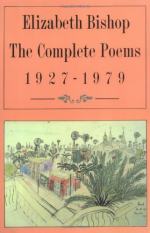
|
| Name: _________________________ | Period: ___________________ |
This test consists of 5 multiple choice questions, 5 short answer questions, and 10 short essay questions.
Multiple Choice Questions
1. What is the name of the metrical foot that appears at the end of lines 1 and 3 in most of the stanzas?
(a) Amphibrach.
(b) Dactyl.
(c) Tribrach.
(d) Anapest.
2. In the first stanza, what does the speaker suggest makes the loss of some things especially easy to accept?
(a) They are part of a distant past.
(b) They seem to want to get lost.
(c) They are small and insignificant.
(d) They are difficult to live with.
3. What is the most reasonable interpretation of the speaker's line 13 claim that they have "lost two cities"?
(a) The speaker no longer lives in either city.
(b) The speaker is no longer interested in either city.
(c) The speaker is not welcome in either city.
(d) The speaker cannot find either city.
4. How many stanzas does "One Art" have?
(a) 9.
(b) 7.
(c) 8.
(d) 6.
5. In line 10, what does the speaker admit to having lost?
(a) Their mother's watch.
(b) Their child's artwork.
(c) Their wedding ring.
(d) Their college diploma.
Short Answer Questions
1. Which word in lines 10 and 11, "And look! my last,/ or next-to-last, of three loved houses went," creates a momentary shift in verb mood?
2. What is the format of "One Art"?
3. Stanzas four through six have which techniques in common?
4. Lines 4 and 6, ending in the words "fluster" and "master," exhibit what type of rhyme?
5. What does the speaker use in line 5 as an example of a common lost object?
Short Essay Questions
1. What difference is there in the way the two refrain lines are repeated throughout the poem?
2. Describe the form of "One Art."
3. On the surface level, what is the main message of "One Art"?
4. Which two verb moods are used in "One Art," and where are they employed?
5. To whom is the parenthetical comment "(Write it!)" addressed in line 19, and how does this comment impact the reader's understanding of the poem?
6. What is the poem's dominant meter, and how is it regularly interrupted?
7. How does the speaker arrange the examples of things that can be lost?
8. How does the change in stanza structure in the final stanza mimic the poem's changing meaning?
9. How does the speaker's diction increase the emotional stakes as the poem progresses?
10. What are the refrains employed in "One Art"?
|
This section contains 899 words (approx. 3 pages at 300 words per page) |

|




